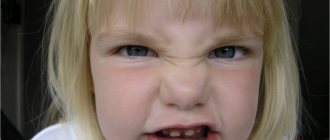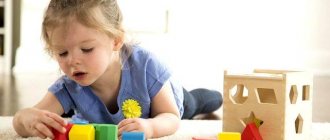Conducting classes on the development of fine motor skills in preschool educational institutions for children 3, 4 and 5 years old
The motor skills of the upper limbs directly interact with the higher functions of the psyche and consciousness: thinking, coordination, attention, observation, speech, imagination, visual memory. Its important role is that the baby’s whole life will require the further use of coordinated, precise movements of the fingers and hands. They are needed for writing, dressing, drawing, and performing other key functions and actions in the process of study, work, and life in general.
Lesson in kindergarten
Important! You can develop motor skills in children in the fourth year of life in the form of classes in kindergarten or together with their parents at home (self-education).
Goals and objectives
The goals and objectives of the development of children's motor skills in children three, four, five years old are as follows:
- stimulate the development of activity and children's speech;
- develop hand and finger movements, coordination;
- teach and train the child in the differences between colors and their comparison;
- develop fine motor skills of the main three fingers: index, thumb, middle;
- prepare the child's hand for writing;
- develop sensorimotor coordination of the upper limbs;
- indirectly affect the overall development of the baby’s intelligence;
- develop lacing skills (lacing, “bow”);
- develop orientation in space (top, bottom, left, right);
- develop perception, attention, creativity;
- develop creativity abilities.
The main types of development of fine motor skills in a child
The grouping of activities, games, and developmental exercises are divided into several types:
- finger games;
- modeling;
- games with small objects;
- drawing;
- finger massage;
- various activities associated with manual work (screwing caps, sorting beads, tearing sheets of paper, assembling mosaics, cutting).
THE IMPORTANCE OF FINE MOTOR SKILLS
Fine motor skills of the hands are a unity of coordinated manipulations that are aimed at performing small precise movements with the hands and fingers. Just a few decades ago, parents did not have problems with the motor skills of their children. After all, the children did a lot of things with their own hands: they helped peel vegetables, make pies, do laundry, sort out cereals, tie shoelaces and fasten buttons. Today, most of these activities are done either by adults, allowing children to play, or by specialized machines. Even Velcro shoes and clothes with zippers deprive the child of the opportunity to practice the fine movements of his fingers.
Meanwhile, a lot says about the importance of fine motor skills. Children with weak motor skills are not ready for writing and often lag behind in speech development. All this affects school performance and leads to increased stress on the child’s nervous system.
Among other things, the state of fine motor skills of the hands directly affects the development of the child:
- self-care skills;
- perseverance;
- thinking;
- attention;
- imagination;
- vocabulary;
- memory.
After all, the centers of the cerebral cortex responsible for fine motor skills are adjacent and closely interconnected with the centers responsible for the development of these areas. By activating the fine motor area, we naturally influence the neighboring ones.
Games for the development of fine motor skills in the second junior group
Games that promote the development of a child's motor skills include the following types of entertainment activities:
- fingered. They are considered a unique way to develop children's speech. Along with the exercises, kids memorize texts, which helps develop attention, memory, imagination, thinking, reaction speed, expressiveness of emotions, etc.;
- origami. Creating paper crafts without using glue is the next option for developing motor skills, which can be interesting for both children and adults;
- lacing is a type of game that is not only useful for general development, but will also help the child in the future;
- games with cereals, sand, beads, bulk substances (stringing, transferring into containers, etc.);
- modeling from clay, dough, plasticine.
Fun dances for preschoolers in kindergarten
WHAT CONTRIBUTES TO HANDBOOK DEXTERITY?
There are many ways to make little fingers more skilled. The following games and activities perfectly develop fine motor skills in children aged 3–4 years:
- fastening buttons, snaps, lacing;
- unscrewing lids on jars and bottles;
- rolling pencils, nuts, spools in the palms;
- modeling from plasticine or dough;
- sorting of cereals (peas, beans, buckwheat, rice);
- finger painting on sand, semolina or buckwheat;
- drawing with finger paints or pencils;
- cutting out figures along the contours;
- games with small details (constructor, mosaic, puzzles);
- stringing large beads on fishing line or wire;
- feeling surfaces made of various materials and textures;
- massage with spiked balls.
When your child paints with finger paints, put on things that you don’t mind getting damaged by paints, and cover the table with protective oilcloth to make subsequent cleaning easier.
Most of these activities captivate children 3–4 years old, especially if parents give them the form of an entertaining game. For example, they suggest not just sorting out the cereals, but helping Cinderella go to the ball, not just touching different surfaces, but imagining yourself as a blind Mole from the fairy tale about Thumbelina, and guessing what you touched.
Exercises for the development of motor skills in the middle group of kindergarten
The list of exercises that promote the development of motor skills includes the following activities:
- drawing with pencils. Their use helps to strain the baby’s hands in order to select the pressure needed to draw lines of different thicknesses and brightness;
- collecting puzzles, mosaics, construction sets;
- fastening and unfastening buttons and locks.
Collecting paper puzzles
Fine motor skills in children from 4 to 7 months
At 4 months, in accordance with the norms of child development, the baby usually holds the rattle tightly, can shake it, put it in his mouth and even transfer it from hand to hand. At the age of 4 to 7 months, the child uses his palms as claws or a rake, that is, he lifts objects of interest to him with a raking motion. The baby can also grab an object with one hand, transfer it to the other, and make a rotational movement of the wrist towards himself in order to examine the thing.
How to develop hand motor skills in a child from 4 to 7 months
What can be done for the development of a child at this age:
- Place toys at some distance from the baby so that he has an incentive to reach for them.
- Let him play with blocks and stuffed animals to develop his hand-eye coordination.
Summarize
| So, a baby between the ages of 4 and 7 months usually develops the following elements of hand motor skills: ● He can reach for objects with one hand. ● He transfers objects from one hand to another. ● He can lift objects using a raking motion with his palm. |
Card file of exercises and games with goals according to the Federal State Educational Standard
The card file of exercises according to federal standards includes the following types of classes:
- to relax your arms (hands);
- for the development of motor skills using an unsharpened hex pencil;
- for the development of motor skills using natural materials (cones);
- for the development of motor skills with the help of a prickly massage ball.
The first type includes the following exercises:
- "Fish" in the water;
- “Helicopter”, which involves winding thread around an elastic band or ball;
- “Hedgehog” with palms;
- “Hare and Fox” with quickly and slowly “walking” fingers;
- “A conversation between two”, involving interaction between several group members;
- “Flight of the Birds” with active hand work;
- “Track” with buttons sewn to the fabric;
- “Pebbles” with plasticine laid out in a straight line;
- “Watch” aimed at active movements of the hands;
- “Lock”, which includes movements of the fingers and hands;
- “Spider” - moving fingers along the wall;
- “Scissors” with cutting movements of the fingers;
- “Firefighter”, which involves running your fingers along a “ladder”;
- “Peck fingers” - connecting the thumb with the rest in turn.
The second type includes the following exercises:
- “Pencil rolling” using the palm of your hand;
- “Making fire” with rolling a pencil up and down between your hands;
- "Slide" with rolling a pencil up and down one hand using the other hand;
- “Spinner” with a pencil spinning on the table;
- “Helicopter” with a pencil spinning in the air;
- “Crane” with lifting an object with two fingers;
- “Excavator” with lifting a pencil with your finger;
- “Swing” with swinging a pencil with two connected fingers.
The third type includes the following exercises:
- “Twist the bump” using your palms;
- “Roll the bump” using your palms on the table;
- “Catch the cone” by throwing it from hand to hand.
The fourth type includes the following exercises:
- rolling an object back and forth on the table;
- rolling an object around the table in a circle;
- finger pressure;
- catching a thrown ball;
- pressing on the ball with both hands;
- moving the ball from hand to hand with acceleration.
Tests for preparing preschool children 6-7 years old for school at home
Finger games and exercises
Finger exercises and games include many variations that require small and large objects of different types and densities. Paper, cereals, bulk and small items are suitable for this.
Important! It is best to accompany lessons with sayings in poetic form. Thanks to this, children will develop their speech apparatus and memory.
Many of the exercises will be useful to the baby in the future (for example, the ability to tie shoelaces, fasten buttons).
Finger drawings
Finger drawings as an element of classes are recommended to be done before lunch. During this period, children are especially active. At first, it is worth conducting a lesson for a couple of minutes, gradually increasing the time to 20 minutes without breaks.
For classes you need to purchase special paints, sold in any store. They have a special consistency that does not require adding water. The lid should fit tightly to the jar.
The sheets you choose should be A3 format so that the child can safely draw and the colors are bright. The presence of “CE” on the box means that the product meets world-class standards.
Massage of palms and fingers
Massage is a key point in the development of children's motor skills. The massage includes stroking the arms from fingers to palms, including the hands. Classes are accompanied by tongue twisters and poems.
Finger massage
Note! Before the massage, you need to warm up the baby's hands. The duration of the procedure should not be more than 5 minutes. Massage should be done for 10 days once a month.
FINGERS PLAYING
However, the most interesting activity for children is finger games: all kinds of rhymes, tongue twisters, nursery rhymes, mini-performances that are performed only with the help of fingers. Here we present several new options for finger games.
But first, here are a few rules for conducting activities that develop fine motor skills:
- Work with your child regularly, include hand massage, games with small parts, creative activities, and finger exercises in your training program.
- Finger gymnastics should last from 5 to 15 minutes, no more, otherwise the baby will get tired and switch his attention to something else.
- Before starting the exercises, you need to warm up your palms by actively rubbing them against each other.
- Remember that now it is difficult for children to perform movements with both hands at once, so start with one, then repeat with the other, and only after that try to synchronize the hands.
- Keep in mind that the child may not remember all the movements or words of the game the first time, this is normal at their age. Everything will work out gradually.
- The baby will also learn to correlate words with movements during the lessons; if he doesn’t succeed right away, encourage him and help him perform the action.
- Move from simple to complex. If a child is offered an exercise that he cannot do, next time he will simply refuse to play.
- Try to interest your child by organizing games with his favorite characters, melodies, and rhymes.
- Do not exercise if your baby is unwell or in a bad mood. Don't force it. There are no useful games against the will of the player.
Classes for the development of fine motor skills in preschool educational institutions
Activities in kindergarten include the same exercises and games as at home.
An example of a summary of a correctional and developmental lesson in a middle group
The lesson plan includes indicating the topic, setting goals, tasks, introductory (psychological mood, warm-up), main (exercises with objects, drawing) and final parts (summarizing, praising each child).
The development of fine motor skills in children 3, 4, 5 years old is an important aspect of the overall development of the child. Before starting classes, you can consult with a speech therapist, neurologist, or pediatrician, who will confirm this. But it should be remembered that all lessons should bring joy and satisfaction to both children and parents, and then the first results will not be long in coming.
Fine motor skills in children from 1 to 3 months
At the age of up to 1 month, in accordance with the norms of child development, the baby’s hands are usually clenched into fists, and the fingers clasp the thumb. If you put a rattle in his hand, he can grab it, and that's all for now. If you run your finger across your baby's palm, he will grab it tightly. However, you should not try to lift it - the child may suddenly let go of the finger. This is just one of many infant reflexes that a child has from birth - the palmar grasp reflex, and the baby has no control over it. At about 3 months of age, the baby's arms begin to relax. The palm is in a half-open position most of the time. Now, if you put a rattle in his hand, he can grab it, bring it to his mouth, or drop it when he stops being interested.
How to develop hand motor skills in a child from 1 to 3 months
During this period, the following actions are recommended for the development of the child:
- Shake a toy in front of him or over his head. The child will reach for it or pat it with his hand.
- Give your child bright objects, if possible in different sizes, shapes and textures.
Summarize
| At this stage, the child develops the following elements of hand motor skills: ● He can squeeze and unclench his palm. ● He brings his hands to his mouth. ● He can hold a toy like a rattle and shake it. |
Fine motor skills in children aged 1 year
Congratulations! Your baby is one year old! At this age, the child’s development is progressing by leaps and bounds, and he can already do a lot of things. Parents are usually impressed by gross motor skills, particularly the long-awaited first steps, but there is also something to be surprised about in the area of fine motor skills. Thanks to improved gross motor skills, the child is increasingly eager to explore the world around him. In the process, fine motor skills are also improved. The baby still cannot grasp the smallest objects, but this achievement is not far off. While your child enjoys exploring and playing with larger objects, such as wooden blocks and wooden puzzles. At this stage, significant progress occurs in the development of hand-eye coordination. Nowadays, the child increasingly uses one hand, but this does not mean that his leading hand has already been determined (that is, he will be left-handed or right-handed).
How to develop hand motor skills in a child aged 1 year
As your child gets older, you can do the following exercises to develop hand motor skills:
- Show your child how to fold paper. You can make an accordion fan or a paper airplane with it.
- Have your child insert different shaped blocks or pegs (square, rectangular, triangular) into the corresponding holes.
- Show him how to stack the blocks on top of each other to make a tower.
- Offer him toys that can be taken apart and put together safely, such as a set of cups that nest inside each other.
- Invite him to sculpt something from plasticine.
- Entrust him with simple housework, such as sweeping, arranging items, or helping you prepare food (stirring pancake batter or putting vegetables in a pan).
- Play together outside, for example, you can throw a ball to each other.
Summarize
| Between the ages of 1 and 2 years, a child develops the following skills and abilities: ● He can build a tower from blocks and immediately break it. ● He plays with boxes, containers and their lids. ● He can lift a moving object, such as a ball. ● He leafs through books. ● He turns the door handles. ● It knows how to insert pins into the corresponding holes. ● He draws with pencils or fingers. ● He knows how to drink from a mug. ● He can feed himself with a spoon (with varying degrees of success). |









